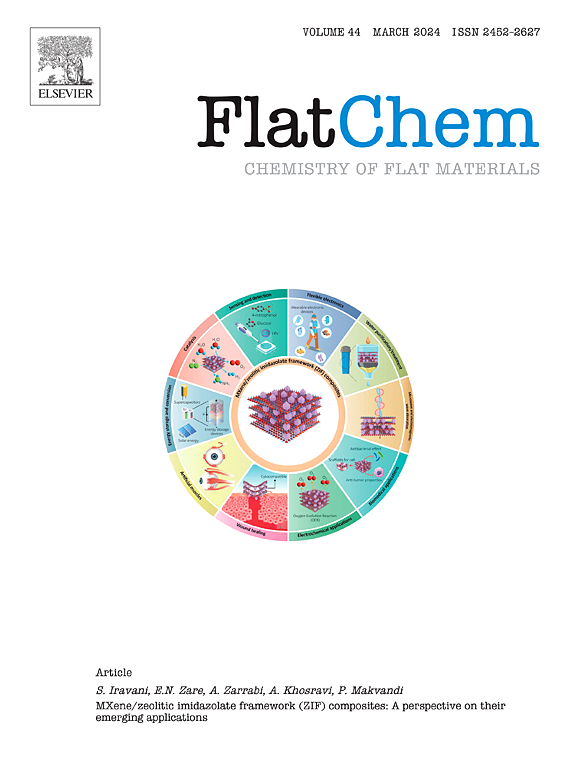Achieving enhanced capacitance retention in an extended potential window for pristine co-HAB metal-organic framework supercapacitors
IF 6.2
3区 材料科学
Q2 CHEMISTRY, PHYSICAL
引用次数: 0
Abstract
2D conductive metal-organic frameworks (MOFs) have garnered attention as new functional materials for energy storage devices due to their high porosity, large surface area, structural tailorability, and versatile functionality. However, their generally low conductivity has hindered their application in device applications. Herein, we present an innovative solution-processable method for the fabrication of high-performance pristine cobalt hexaaminobenzene (Co-HAB) metal-organic framework (MOF) supercapacitors. The Co-HAB electrodes were effectively deposited onto nickel foam substrates using electrophoretic deposition (EPD). The EPD induced a layer-by-layer assembly mechanism for the Co-HAB nanosheets, which resulted in a binder free MOF-based symmetric supercapacitor that demonstrated superior electrochemical performance in a wide potential window of 0.0–1.2 V. Notably, the obtained Co-HAB MOF supercapacitors exhibited an impressive conductivity, operating at ultra-high charge-discharge rates of up to 4000 mV s−1, and achieved an outstanding areal specific capacitance of 13.77 mF cm−2. Furthermore, the Co-HAB supercapacitors exhibited remarkable long-term cycling stability, with 105 % of capacitance retention after 10,000 cycles, marking the best retention reported for an MOF to date. The outstanding performance of the Co-HAB supercapacitor can be attributed to the binder-free EPD process and the conductive 2D MOF nanosheets featuring abundant nanopores, which facilitate efficient electron transfer and fast ion diffusion. These encouraging results suggest a promising avenue for exploring pristine conductive MOFs as functional materials for high-performance supercapacitors and other energy storage solutions.

在原始共hab金属有机框架超级电容器的扩展潜力窗口中实现增强的电容保持
二维导电金属有机框架(mof)由于其高孔隙率、大表面积、结构可定制性和多功能性而成为储能器件的新型功能材料。然而,它们普遍的低电导率阻碍了它们在器件应用中的应用。在此,我们提出了一种创新的溶液可加工方法,用于制造高性能原始六氨基苯钴(Co-HAB)金属有机框架(MOF)超级电容器。采用电泳沉积(EPD)技术将Co-HAB电极有效地沉积在泡沫镍基体上。EPD诱导了Co-HAB纳米片的逐层组装机制,从而形成了无粘结剂的mof对称超级电容器,在0 - 1.2 V宽电位窗口内表现出优异的电化学性能。值得注意的是,所获得的Co-HAB MOF超级电容器表现出令人印象深刻的导电性,在高达4000 mV s−1的超高充放电速率下工作,并实现了13.77 mF cm−2的出色面比电容。此外,Co-HAB超级电容器表现出显著的长期循环稳定性,在10,000次循环后,电容保持率为105%,这是迄今为止报道的MOF的最佳保持率。Co-HAB超级电容器的优异性能可归因于无粘结剂EPD工艺和具有丰富纳米孔的导电二维MOF纳米片,这些纳米片有助于高效的电子转移和快速的离子扩散。这些令人鼓舞的结果为探索原始导电mof作为高性能超级电容器和其他储能解决方案的功能材料提供了一条有希望的途径。
本文章由计算机程序翻译,如有差异,请以英文原文为准。
求助全文
约1分钟内获得全文
求助全文
来源期刊

FlatChem
Multiple-
CiteScore
8.40
自引率
6.50%
发文量
104
审稿时长
26 days
期刊介绍:
FlatChem - Chemistry of Flat Materials, a new voice in the community, publishes original and significant, cutting-edge research related to the chemistry of graphene and related 2D & layered materials. The overall aim of the journal is to combine the chemistry and applications of these materials, where the submission of communications, full papers, and concepts should contain chemistry in a materials context, which can be both experimental and/or theoretical. In addition to original research articles, FlatChem also offers reviews, minireviews, highlights and perspectives on the future of this research area with the scientific leaders in fields related to Flat Materials. Topics of interest include, but are not limited to, the following: -Design, synthesis, applications and investigation of graphene, graphene related materials and other 2D & layered materials (for example Silicene, Germanene, Phosphorene, MXenes, Boron nitride, Transition metal dichalcogenides) -Characterization of these materials using all forms of spectroscopy and microscopy techniques -Chemical modification or functionalization and dispersion of these materials, as well as interactions with other materials -Exploring the surface chemistry of these materials for applications in: Sensors or detectors in electrochemical/Lab on a Chip devices, Composite materials, Membranes, Environment technology, Catalysis for energy storage and conversion (for example fuel cells, supercapacitors, batteries, hydrogen storage), Biomedical technology (drug delivery, biosensing, bioimaging)
 求助内容:
求助内容: 应助结果提醒方式:
应助结果提醒方式:


